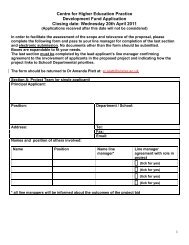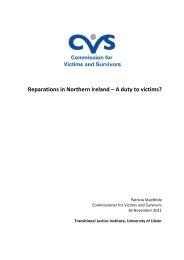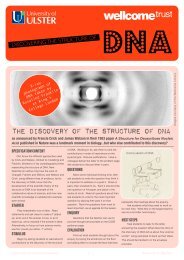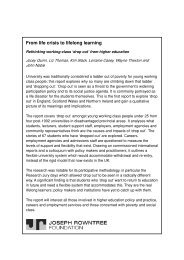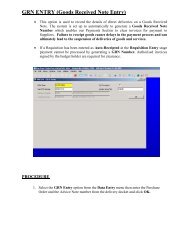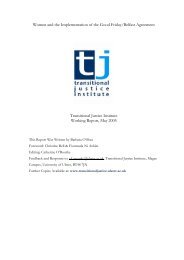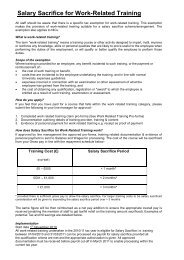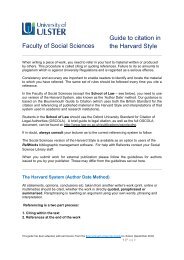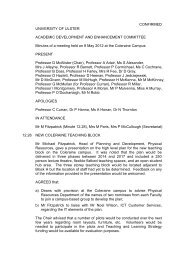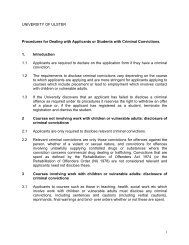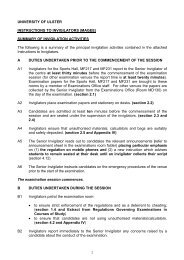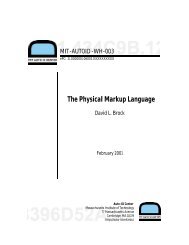Fire Safety Checklist(FSC1) - University of Ulster
Fire Safety Checklist(FSC1) - University of Ulster
Fire Safety Checklist(FSC1) - University of Ulster
You also want an ePaper? Increase the reach of your titles
YUMPU automatically turns print PDFs into web optimized ePapers that Google loves.
<strong>Fire</strong> <strong>Safety</strong> <strong>Checklist</strong> (<strong>FSC1</strong>)<br />
The purpose <strong>of</strong> the inspection is to ensure that the area is free <strong>of</strong> fire hazards and has proper and sufficient<br />
fire prevention equipment, evacuation plans and escape routes. See overleaf for Guidance Notes.<br />
AREA CHECKED:<br />
1. Are the emergency exits and escape routes clearly<br />
marked?<br />
YES NO ACTION<br />
<br />
2. Are the emergency exits unlocked ? <br />
3. Are escape routes unobstructed and full width ? <br />
4. Are wedges promptly removed from fire doors ? <br />
5. Is emergency procedure information clearly displayed ? <br />
6. Is there unobstructed access to hose reels, extinguishers<br />
and fire alarm call points (break glasses) ?<br />
7. Are appropriate fire extinguishers in place and wall<br />
mounted ?<br />
8. Have all fire extinguishers been tested during the last 12<br />
months ?<br />
<br />
<br />
<br />
9. Is rubbish and waste material cleared promptly ? <br />
10. Has all electrical equipment been PAT tested in line with<br />
the <strong>University</strong>'s Health and <strong>Safety</strong> Policy ?<br />
11. Are there adequate numbers <strong>of</strong> electrical sockets to avoid<br />
overloading ?<br />
12. If portable heaters are in use, are they in a safe position<br />
and have they been authorised ?<br />
13. Are flammable liquids in use kept to minimum quantities<br />
and are they stored in a flammable liquids store ?<br />
<br />
<br />
<br />
<br />
14. Is the <strong>University</strong> Smoking Policy enforced ? <br />
15. Have emergency evacuation drills been carried out in all<br />
areas under your control during the last 12 months ?<br />
Signed: Date:<br />
FIRELIST.NTE 26 May 1998
1. Emergency exits should be clearly marked with a pictogram <strong>of</strong> a white running man on a green background with a representation <strong>of</strong> a<br />
fire and with or without the words "Emergency exit". If such signs are not clearly marked along the length <strong>of</strong> the emergency escape route and on<br />
the final exit door please contact Physical Resources. If the signs are obstructed please take steps to have the obstruction cleared.<br />
2. In general emergency exists should open quickly and easily in the direction <strong>of</strong> escape. Push bars and turn knobs are standard for doors<br />
which are not openable from the outside. In very exceptional circumstances keys may be placed in break glass boxes beside the doors but this is<br />
generally unacceptable unless there is an overwhelming need for such a system. Please contact Health and <strong>Safety</strong> Services if such a system exists<br />
in your area. In all cases there must never be a locked door on an escape route unless there is some quick and easy means <strong>of</strong> opening it. If this is<br />
not the case please contact Physical Resources or Health and <strong>Safety</strong> Services.<br />
3. The width <strong>of</strong> escape routes is designed to allow specified numbers <strong>of</strong> people to pass along in a given time and to provide a fire resistant<br />
route to the outside <strong>of</strong> the building. Placing cupboards, equipment, chairs, etc along escape routes is unacceptable as it reduces the ability <strong>of</strong><br />
people to exit along such routes and can lead to delays in evacuating buildings in an emergency. This can be particularly important in thick smoke<br />
or in darkness. In addition flammable items such as chairs can themselves catch fire and block emergency escape routes. If the escape routes are<br />
partially or wholly blocked please take steps to have the obstruction removed as soon as possible.<br />
4. Self-closing fire doors are an important means <strong>of</strong> controlling the spread <strong>of</strong> fire and smoke and are an integral part <strong>of</strong> the designed fire<br />
precautions. <strong>Fire</strong> doors which are clearly marked, should therefore not be wedged open routinely. In exceptional circumstances, such as when<br />
moving furniture etc the <strong>University</strong> does permit wedges to be used to keep fire doors open since it reduces the risk <strong>of</strong> injury to those moving the<br />
items but these MUST BE REMOVED AS SOON AS POSSIBLE after it is no longer required for the door to be open. If fire doors have been left<br />
wedged open it is everyone's responsibility to remove the wedge and allow the doors to close. If fire doors are regularly wedged open please<br />
report this to Physical Resources or Health and <strong>Safety</strong> Services.<br />
5. Blue and white posters detailing the emergency procedures are displayed throughout the <strong>University</strong>. These should be displayed beside<br />
each fire alarm call point. If this is not the case then contact Physical Resources. If the view <strong>of</strong> these posters has been obstructed then whatever is<br />
causing the obstruction should be removed as soon as possible.<br />
6. Should a small fire be discovered it may be possible to extinguish such a fire before it becomes too large. It is therefore important that<br />
fire fighting equipment can be easily reached to enable such action to be taken . If obstructed then take steps to remove the obstruction as soon as<br />
possible.<br />
7. Removal <strong>of</strong> fire extinguishers to other positions may mean that small fires cannot be tackled, allowing the fire to spread and thus<br />
endangering life and property. Use <strong>of</strong> the wrong type <strong>of</strong> extinguisher can endanger life by being ineffective (thus delaying escape) or present other<br />
hazards, eg. water on electrical fires. Wall mounting <strong>of</strong> fire extinguishers ensures that they are more visible and less likely to be damaged and are<br />
therefore more likely to function correctly in an emergency. Please ensure that all extinguishers within your section are in the correct place and <strong>of</strong><br />
the correct type and are placed in their mount at all times. If an extinguisher is missing or inappropriate or if a wall mount is not available then<br />
report this to Physical Resources as soon as possible.<br />
8. Regular testing <strong>of</strong> fire extinguishers helps to ensure that they function correctly in an emergency. The <strong>University</strong> therefore requires that<br />
all fire extinguishers are tested every 6 months. This testing is normally carried out by a contractor. Verification that the test has been carried out<br />
can be obtained by checking the label on each extinguisher. If this indicates that the extinguisher has not been tested during the last 12 months<br />
then please report this to Physical Resources.<br />
9. Many fires are caused because flammable material in the form <strong>of</strong> rubbish and waste is allowed to collect unnecessarily. Prompt removal<br />
<strong>of</strong> all such material removes the fuel and thus prevents such fires. If rubbish has been allowed to accumulate please take steps to have it removed<br />
as soon as possible.<br />
10. Faulty electrical equipment is a major cause <strong>of</strong> all fires in the workplace. The <strong>University</strong>'s health and safety policy with regard to<br />
electrical testing must therefore be enforced. All equipment which has failed a PAT test or has not been tested in accordance with the <strong>University</strong>'s<br />
policy should be removed from use.<br />
11. Overloading <strong>of</strong> electrical sockets is another major cause <strong>of</strong> fires. You should therefore ensure that there are sufficient sockets to prevent<br />
overloading occurring. If additional electrical sockets are required please contact Physical Resources.<br />
12. In general portable heaters should not be used. In very exceptional circumstances, such as breakdown <strong>of</strong> mains heating they may be<br />
authorised by Physical Resources for use. In this case it must be ensured that they are not left unattended, are placed well away from any material<br />
which they could set alight and have sufficient air space around them to avoid the heater itself overheating.<br />
13. The amount <strong>of</strong> flammable liquids in use at any one time should always be kept to a minimum (at most 50 litres <strong>of</strong> flammable liquid<br />
should be kept in any laboratory). Quantities <strong>of</strong> less than highly flammable liquids may be stored in any suitable small closed vessel. Any larger<br />
quantities must be kept in a suitably placed fire-resisting cupboard or bin. The aggregate quantity <strong>of</strong> highly flammable liquids stored in a<br />
workroom or laboratory must not exceed 50 litres.<br />
14. Discarded cigarettes and matches are another major cause <strong>of</strong> fires in general. It is therefore important that the <strong>University</strong>'s smoking<br />
policy is enforced to reduce the risk <strong>of</strong> such fires starting. If the policy is not enforced please take steps to ensure that it is.<br />
15. Emergency evacuation drills are an important method <strong>of</strong> testing alarms, escape routes and ensuring that all are aware <strong>of</strong> the emergency<br />
procedures. If an emergency evacuation drill has not been carried out for all your areas within the last 12 months please contact Health and <strong>Safety</strong><br />
Services.



